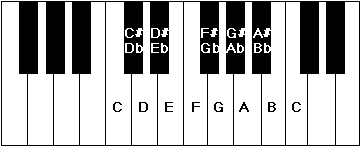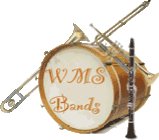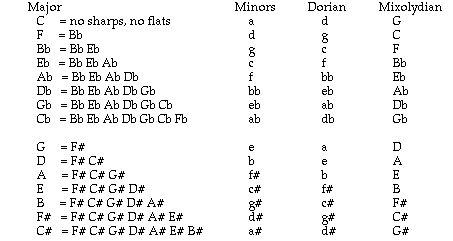The Chromatic Scale

We are going to use the piano keyboard diagram to help us
understand and learn the chromatic scale. First, let's
briefly get a sense of how the piano keyboard is laid out.
Notice:
- There are black & white keys. Did you know that
you wouldn't have to have two different colors or have
some keys raised a bit?? It is possible to build a piano
with all white keys. It would look like the diagram
below:

And how would we ever find our way around?????
- So, one of the functions of the black keys is to help
us find our way around the keyboard. The black keys are
laid out in groups of twos and threes.
- The white key just to the left of the group of two is
a C (look on the keyboard below)

- If you know that, I bet you can name all the rest of
the keys. Try it. Start on the C to the left, say the
letter names up the musical alphabet and see if you land
on the next C. If not, look at the next diagram to see
what went wrong.

- Look at the diagram above and notice how the sharps
and flats are laid out. A sharp is defined as the
note that is one half step higher then the note
you are starting on. A half step on the piano is the very
next key. So, C# is the very next key to the right after
the C and it happens to be a black key.
- Logically enough, flats are defined as the
note that is one half step lower than the note you
are starting on. So, Db is the next key to the left of
D.
- Did you notice that C# and Db are the same key??? All
notes have more than one name. The formal word for this
concept is enharmonic tones. C# and Db are enharmonic
tones (they sound the same, but have different
names).
- Where is E#??? Where is Fb??? What is a double
sharp??? What is a double flat??? If these questions
interest you, click here.
Sooo... What does all this have to do with the Chromatic
Scale???
A chromatic scale is a scale containing 12 equal
divisions of the octave. Put another way, it is every key on
the piano within one octave. (An octave is from C to C, or
F# to F#, or A to A, or...) So a chromatic scale starting on
C is:
C C# D D# E
F F# G G# A A# B C
(then come down & use the flat names)
C B Bb A Ab G Gb F E Eb D Db C
Put your finger on the piano keys below and say the names
of the notes in a C chromatic scale.

Here is a C chromatic scale, one octave. Click the
play bar to hear a C chromatic scale, one octave.

return to
top
Now, take that information to your instrument...
MEMORIZING...
Look at the piano keyboard while you play each note of
the chromatic scale on your instrument. There may be a few
notes that you need to look up, but notice most of them you
already know - What is an A# you ask?? Why, it is a Bb and
you probably do know that fingering! (Click here for a larger sized keyboard that
you can print out to work with and to keep in your band
folder for reference)
Play up and down a few times. Keep looking at the
keyboard so your eyes learn to visualize the keyboard and so
your brain learns the note names -- it will help you
memorize faster.
OK, so you know what a chromatic scale is; now the hard
part is memorizing it on your instrument. If you had a long
poem to memorize, would you recite it all the way through
over and over again? Of course not; you would break it into
small chunks and memorize one verse at a time.
Do the same with the chromatic scale. It is easy to
memorize a few notes, so do from C to F.
C C# D D# E
F F E Eb D Db C
After you have played that over about 15 times I'll bet
you can do it from memory. Easy, eh?? (Say the note names to
yourself, and look at the keyboard while you work on
it.)
Now learn from F to A. Then from A to C. Now you are
ready to put it together!
Want the BAD NEWS? Great, you can play it from memory
today. But guess what? When you pick up your instrument
tomorrow, you will probably have forgotten it. Sigh... But
the GOOD NEWS is that it won't take you as long to relearn
it!
^^^^^^^^^^^^^
By the way... When someone asks you to play a
chromatic scale, it doesn't have to start on a C. You could
play a G chromatic, or a Bb chromatic, or an F chromatic, or
any other that you wish! Just make sure you go one or two
octaves, whatever is specified. (Don't play from C to C# -
that is more than an octave!)

return to
top |










